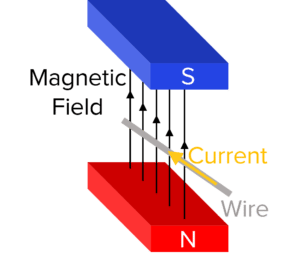The Motor Effect
The Motor Effect Revision
The Motor Effect
The motor effect is where a force is exerted on a current-carrying wire due to the presence of a magnetic field. There are a range of practical uses of the motor effect including electric motors and loudspeakers.
The Motor Effect and Fleming’s Left-hand Rule
When a current-carrying wire is placed in a magnetic field, the magnetic field produced by the current in the wire interacts with the external magnetic field. This results in the wire experiencing a force. This is called the motor effect.
The greatest force is experienced when the wire is perpendicular to the magnetic field. If the wire is parallel to the magnetic field, there is no force experienced. If the wire is at an angle between perpendicular and parallel, a smaller force is experienced.


The force is always perpendicular (at right angles) to both the magnetic field and the current.
You can work out the direction of the force using Fleming’s Left-hand rule:
- Your thumb is in the direction of the force.
- Your first finger is the direction of the magnetic field.
- Your second finger is the direction of the current.
Calculating the Size of the Force
For a current-carrying wire placed in a magnetic field at right angles to the field, the size of the force can be calculated using the following equation:
F=BIl
- F= the force in Newtons \text{(N)}.
- B= the magnetic flux density (the strength of the magnetic field) in tesla \text{(T)}.
- I= the current in amps \text{(A)}.
- l= the length of the wire in metres \text{(m)}.
Electric Motors
We can use the motor effect to produce rotational motion, using a motor. The motor works as follows:
- The magnetic field exerts a force on the loop of wire.
- Because the current is travelling in opposite directions in each side of the loop, the forces are in opposite directions.
- This causes the loop of wire to rotate.
- As the split-ring commutator rotates with the coil, the contacts with the positive and negative voltage swap.
- This reverses the current in the wire loop.
- As a result, the forces on the wire swap.
- This keeps the wire loop in constant rotation.
You can use Fleming’s Left-hand Rule to work out which way the loop will rotate.

Loudspeakers

Loudspeakers also use electromagnetic effects. This is how they work:
- A coil is wrapped around the south pole of a magnet and attached to the base of a paper cone.
- When an ac current is sent through the coil, it experiences a force.
- This force causes the coil to move, which moves the paper cone.
- The current through the coil is then reversed. This causes a force in the opposite direction, causing the coil and paper cone to move in the opposite direction.
- By quickly switching the current and varying the size of the current according to the signal, the paper cone can be made to vibrate, creating sound waves.
- The frequency of the sound wave is the same as the frequency of the ac current. This is used to control the pitch of the sound.
Example: Calculating the Size of the Force
A current-carrying wire of length 20\text{ cm} is placed in a magnetic field with magnetic flux density 0.5 \text{ T}. The wire experiences an upwards force of 2\text{ N}. Calculate the current in the wire.
[3 marks]

\textcolor{00d865}{20 \text{ cm}} = 0.2 \text{ m} \\ \bold{F = BIl}
Rearrange to find I:
\begin{aligned} I &= \dfrac{F}{Bl} \\ &= \dfrac{\textcolor{aa57ff}{2}}{0.2 \times \textcolor{d11149}{0.5}} \\ &= \bold{20} \textbf{ A} \end{aligned}
The Motor Effect Example Questions
Question 1: Describe how to maximise the force exerted on a current-carrying wire placed in a magnetic field.
[1 mark]
Place the wire perpendicular to the magnetic field.
Question 2: The following diagram shows a current-carrying wire in a magnetic field. Use Fleming’s Left-hand rule to determine the direction of the force felt by the wire.

[1 mark]
Question 3: A 10 \text{ cm} long wire is placed in a 2 \text{ T} magnetic field. The wire is placed perpendicular to the field. A current of 5 \text{ A} is sent through the wire. What is the size of the force felt by the wire?
[2 marks]
Question 4: Explain why loudspeakers require an ac current.
[5 marks]
When a current flows through the coil in the speaker, the coil experiences a force.
This force causes the the coil and the paper cone to move.
The current then must be reversed so that the coil and paper cone move in the opposite direction.
The switching of an ac current causes the paper cone to vibrate.
This vibration causes sound waves.







